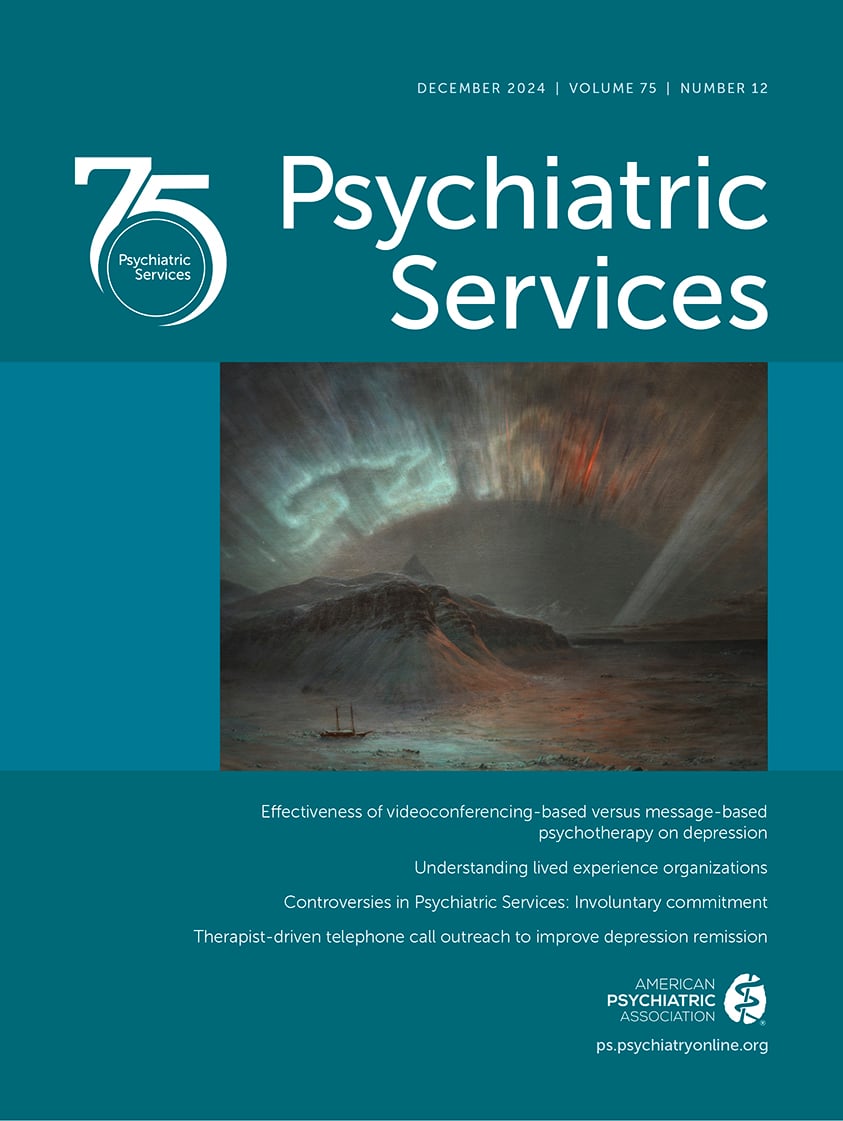Psychiatric Services
- Volume 42
- Number 4
- April 1991
Article
Publication date: 01 April 1991
Pages347–349This month's guest authors are affiliated with the substance abuse treatment and treatment research unit of the Connecticut Mental Health Center and the department of psychiatry at Yale University School of Medicine, where Dr. Rosen is instructor and Dr. ...
https://doi.org/10.1176/ps.42.4.347Publication date: 01 April 1991
Page352The word "mnemonic" was inadvertently omitted from the last paragraph of the letter entitled "The Head Mnemonic" by Neil B. Edwards, M.D., on page 96 of the January issue. The paragraph should have read, "I fondly refer to my HEAD MNEMONIC as my ...
https://doi.org/10.1176/ps.42.4.352Publication date: 01 April 1991
Pages363–365Dr. Sharfstein's introduction: In our zeal to replace psychiatric hospitalization with cost-effective alternatives, we must take care to ensure that appropriate resources remain available for the most severely symptomatic patients with life-threatening ...
https://doi.org/10.1176/ps.42.4.363Publication date: 01 April 1991
Pages374–379Estimates of the prevalence of comorbidity of psychiatric disorders and mental retardation in community and clinical populations range from 14.3 to 67.3 percent. A widevariety of disorders have been reported in this population, including schizophrenia, ...
https://doi.org/10.1176/ps.42.4.374Publication date: 01 April 1991
Pages380–389Interest in the mental health service needs of hearing-impaired persons has expanded over the past 35 years, but the availability and accessibility of clinical services have lagged behind developments in research. Despite federal mandates, deaf Americans' ...
https://doi.org/10.1176/ps.42.4.380Publication date: 01 April 1991
Pages389–394Medical and surgical in patients with coexisting psychiatric disorderspose several challenges to the consulting mental health professional in the general hospital. A major challenge is determining whether presenting signs and symptoms have a medical or ...
https://doi.org/10.1176/ps.42.4.389Publication date: 01 April 1991
Pages395–400Psychiatrists' axis III diagnoses of physical illnesses in 357 psychiatric patients were compared with diagnoses by a physician's assistant using a standardized medical history form. The physician's assistant detected nearly three times as many physical ...
https://doi.org/10.1176/ps.42.4.395Publication date: 01 April 1991
Pages400–403Data from a 1980 discharge survey of general hospitals were analyzed to determine the prevalence of cases with coexisting diagnoses of mental and substance abuse disorders. Twelve percent of total cases (or 208,000 episodes) had dual diagnoses, a ...
https://doi.org/10.1176/ps.42.4.400Publication date: 01 April 1991
Pages403–405Over a four-month period, 113 consecutive admissions to a general psychiatric ward of a Veterans Affairs hospital were evaluated for the presence of a substance use diagnosis as well as type of discharge (regular or irregular). Of the patients studied, 61 ...
https://doi.org/10.1176/ps.42.4.403Publication date: 01 April 1991
Pages406–408Eighty-five of 116 randomly selected clients receiving case management services at a comprehensive community mental health center responded anonymously to a survey questionnaire that included two measures of self-reported alcohol use: questions about ...
https://doi.org/10.1176/ps.42.4.406Publication date: 01 April 1991
Pages408–412Although many psychiatric inpatient units have banned smoking, the authors suggest that problems associated with implementation of no-smoking policies in these settings have been underreported. Over a two-year period after implementation of a smoking ban ...
https://doi.org/10.1176/ps.42.4.408Publication date: 01 April 1991
Pages413–418A brief historical review of military psychiatry in the United States Army is presented, focusing on the development of psychiatric treatment of soldiers with acute stress reactions. The authors outline the current roles of the military psychiatrist ...
https://doi.org/10.1176/ps.42.4.413Past Issues
View Issues Archive
Vol. 75 | No. 12

Vol. 75 | No. 11

Vol. 75 | No. 10
